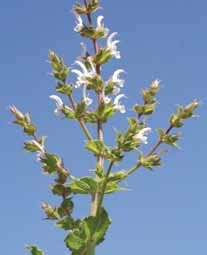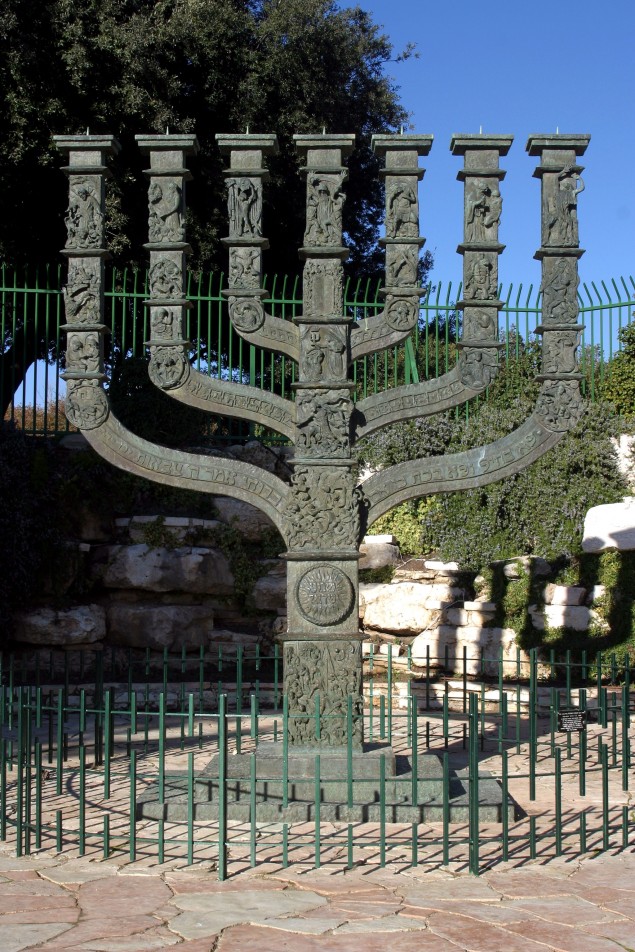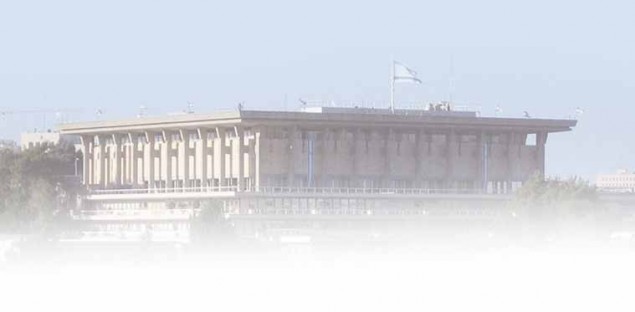On and Off the Beaten Track… The Menorah—Official Symbol of the State of Israel
The Knesset Menorah stands about fifteen feet high across from the main entrance to the Knesset. Photo: www.sasson-photos.com
Upon the founding of the State of Israel, the menorah was chosen as its official symbol. Today, the Knesset Menorah, a bronze monument, stands about fifteen feet high, across from the Knesset gates, symbolizing the eternity of the Jewish people.
The recent discovery of an old seal near Akko underscored the significance of the menorah as a recognized symbol of Jews, Judaism and the Land of Israel throughout history. The 1,500-year-old seal, with the prominent image of a seven-branched menorah, has been identified as a “kosher bread” stamp, an ancient OU, so to speak, which was used by Jewish residents of the area during the Byzantine period to certify that the bread was fit for Jewish consumption.
The menorah is initially presented in the Torah as one of the key keilim (implements) of the Mishkan, the Tabernacle, that the Jewish people built in the desert (Shemot 25:31-39). Hundreds of years later, the menorah came to symbolize the Beit Hamikdash, the Holy Temple, in Jerusalem. Along with the incense altar and the table for the showbread, the menorah stood in the outermost chamber of the sanctuary and was lit each evening by one of the Kohanim.
According to researchers at Neot Kedumim, the Biblical Landscape Reserve in Israel, the Torah’s description of the menorah, which incorporates botanical imagery (stem, branches, flowers, blossoms, almonds), evokes images of one example in nature in particular—the Salvia Palaestina. According to one theory, the shape of this plant served as a model for the menorah.
When the Second Temple was destroyed by the Romans on Tishah B’Av in the year 70 ce, the victors portrayed their subjugation of the Jewish people and ruination of our Temple with the Arch of Titus, a large victory arch outside the Colosseum in Rome. The central motif of the arch is the menorah and other Temple treasures being carried away by the triumphant Romans. The Destruction of the Temple, the capture of the menorah and the subsequent failure of the Bar Kochba Rebellion sixty years later effectively ended Jewish autonomy in the Land of Israel and presaged the start of a 1,900-year-long exile.
 The plant Salvia Palaestina, whose shape resembles the menorah. Courtesy of Avinoam Danin/Flora of Israel Online
The plant Salvia Palaestina, whose shape resembles the menorah. Courtesy of Avinoam Danin/Flora of Israel Online
The Knesset Menorah stands proudly in a small plaza just across from the main entrance to the Knesset. In a certain sense, with the rebirth of modern Israel, the menorah has returned home. I must admit that while writing this article, I struggled with the sentence above. On the one hand, until the Temple is restored and the keilim as described in the Torah are once again in use, how can anyone dare to suggest that the menorah has returned home? On the other hand, many Jews view the establishment of modern Israel as “reishit Geulateinu,” “the beginning of our Redemption,” and in that sense, this impressive menorah symbolizes the rebirth of a nation in its ancient homeland.
Indeed, the elaborate artwork on the Knesset Menorah’s branches depicts our connection to our past and reminds us that in less than sixty-five years, Israel has grown from a country with 5 percent of the world’s Jewish population to one where 40 percent of Jews now reside, making Israel the largest Jewish community in the world. Achieving the dream of “vkabtzeinu yachad me’arba kanfot ha’aretz,” “gather us together from the four corners of the earth,” as we say in the weekday Amidah, brings us one step closer to the Geulah. Thus, in a very real sense, the menorah has come home along with the Jewish people who have made Israel their home.
The Knesset Menorah, which today serves as the official symbol of the State of Israel, was crafted by Benno Elkan, a Jewish-British sculptor, and was donated to Israel by Great Britain in 1956. Like its ancient predecessor, it too has a central stem and six branches, three on each side. Unlike the menorah of old, however, the branches of the Knesset Menorah contain twenty-nine engravings that capture the spiritual struggles of the Jewish people as well as key moments and memorable events in Jewish history—from Abraham to the birth of modern Israel.
While the scenes depicted are scattered and in no particular order, what I find most meaningful is that the artist chose to engrave the words “Shema Yisrael” in a circle at the menorah’s base. The central and pivotal expression of our faith is placed at the site that supports and sustains all of the branches. The symbolism is clear to visitors of all backgrounds and religious persuasions: Jewish life and existence is based upon our unwavering faith.
The panel just above Shema evokes images of the Shoah and the Warsaw Ghetto Uprising, while the panel beneath depicts the struggle to establish the State and the pioneers who turned Israel into the flourishing country that it is today. The central column also includes, at the top, an image of Moshe Rabbeinu’s hands being supported by Aharon and Chur during the battle against Amalek, and beneath that, the Tablets.
The branch on the extreme left depicts the scope of Jewish history: Yeshayah’s prophecy for the End of Days, Rabbi Yochanan ben Zakkai expounding Torah She’ba’al Peh at Yavneh after the Second Temple was destroyed, the Golden Age of Spanish Jewry and the Babylonian Exile. Other panels on various branches include King David triumphantly displaying Goliath’s severed head, Yechezkel’s Vision of the Dry Bones, the Bar Kochba Rebellion, Yaakov wrestling with the angel, Yirmiyah mourning the Destruction of the First Temple and the clandestine immigration during the British Mandate, which brought thousands of Jews home.
Perhaps the most dramatic part of the menorah is the Biblical verse engraved across the bottom of the lowest branches. “‘Not through army and not through strength, but through My spirit,’ said Hashem, Master of Legions” (Zechariah 4: 6). The verse appears in the context of a chapter that, among other things, describes the prophet’s vision of a menorah with olive branches on each side.
Many families and groups who are visiting Jerusalem stop at the menorah for a wonderful photo opportunity. When you do, try to spend a few minutes looking through the lens of history depicted on the branches. Recognize that what guarantees you the opportunity to be standing there goes beyond the power of Israel’s Phantom Jets and M16s. The menorah reminds all of us of the Divine promise of an eternal connection between God’s people and our ancient homeland.
Peter Abelow is a licensed tour guide and the associate director of Keshet: The Center for Educational Tourism in Israel. Keshet specializes in creating and running inspiring family and group tours that make Israel come alive “Jewishly.” He can be reached at 011.972.2.671.3518 or at peter@keshetisrael.co.il.


